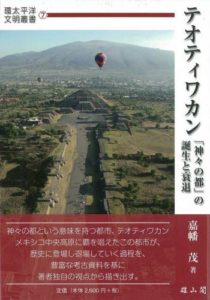
Kabata Shigeru
Tokyo: Yuzankaku, 2019
Reviewed by Yagi Hiroaki (Harvard-Yenching Institute Visiting Fellow in the Mesoamerican Archaeology Training Program, 2018-19)
Teotihuacan is one of the most studied sites in Mesoamerica due to its uniqueness. We can find much evidence which suggests Teotihuacan reached the state level and it was more widely influential than any other civilization of its time in Mesoamerica. The results of research to date invite comparison with other states of the ancient world; however, the formation of statehood and the process of its abandonment are still an ongoing debate. An important new book, Teotihuacan: Birth and decline of the “birthplace of the gods,” written by Kabata Shigeru, Associate Professor of Universidad de las Americas Puebla, Mexico, contributes to these critical issues.
In the first two chapters, the author verifies the reasons why Teotihuacan became a state. One of the unique points of his study is that he analyzes the data of Tlalancaleca, a preceding site of Teotihuacan, to understand the factor of state formation in Teotihuacan. The data from Tlalancaleca shows that Teotihuacan inherited many elements which had already been developed by preceding societies. This shows that Teotihuacan did not emerge independently; there was a historical continuity from the preceding society to Teotihuacan, and he claims that we should understand the flourishing of Teotihuacan as an accumulation of culture which developed in the pre-society of Teotihuacan.
The latter half of the book challenges the second big theme; why did Teotihuacan decline? The author provides a new perspective, which he calls a “multilayered exchange system.” This perspective emphasizes the importance of considering the dynamism and uniqueness of surrounding societies which flourished contemporaneously with Teotihuacan.
While theoretical perspectives are important, so too is the data supporting them. In the next two chapters, the author verifies the availability of his new theoretical perspective based on archaeological data from several sites around Teotihuacan. It is noteworthy that he analyzes two kinds of archaeological material, obsidian and imported pottery, and the results indicate that the periphery societies had their own strategies in exchange. Dr. Kabata suggests that these strategies relate deeply to the decline of Teotihuacan. He concludes that the domination of exchange by Teotihuacan gave surrounding societies a chance to establish their own strategies which were not dependent on Teotihuacan, and this phenomenon led Teotihuacan to decline.
This book is more than just an introductory book on the Teotihuacan. Through reading this book, we can understand that the author and his team maintain the balance between theory and data in archaeological research that so many scholars fail to achieve. His unique perspectives have been verified based on the data acquired by the author and his research team.
